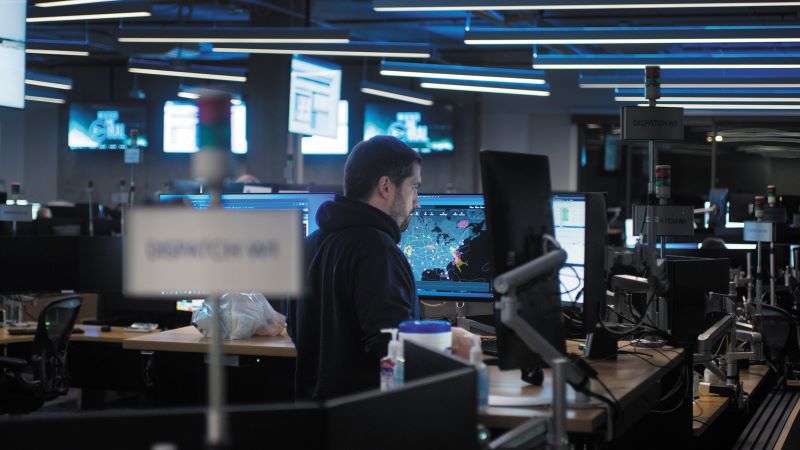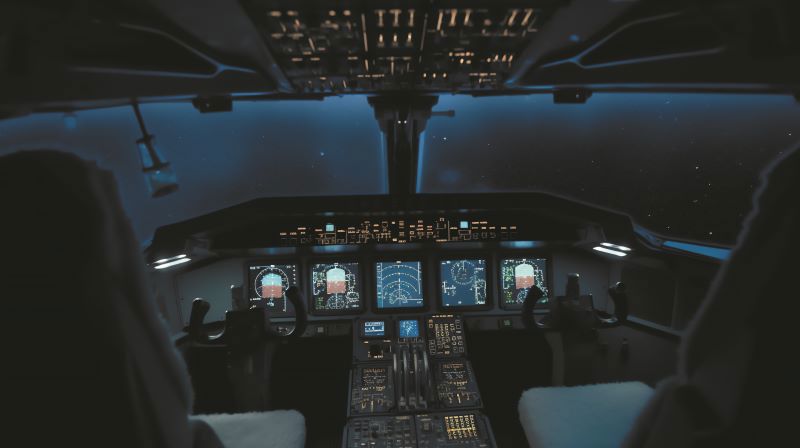
With the emergence of AI chatbots like ChatGPT, the world seems to be starting to grasp the impact artificial intelligence is likely to have on our lives. But despite the lurid headlines about AI taking over the world, the reality is that the use of AI systems remains niche.
This is also the case in ATC, an industry where rigorous safety requirements can lead to a reluctance to embrace new technologies. But with AI, this tendency needs to be set aside, says Sheldon Jacobson, professor of computer science at the University of Illinois in the USA.
“We often bemoan the fact that AI is threatening many jobs, yet we have a shortage of air traffic controllers,” says Jacobson. “Using AI could alleviate some of the shortages. If a controller can do their job more effectively and efficiently and maintain the necessary level of safety – which is non-negotiable – it is a win-win.”
Or as Janet Northcote from the European Aviation Safety Agency (EASA) says, “The use of Artificial Intelligence is having a major impact in air traffic management. In the post-pandemic period, air traffic is recovering and is anticipated to continue to grow in the coming years. In this context, AI assistants can be used to optimise air traffic flow management, reducing delays and increasing efficiency.”
It is not simply the skills shortage that makes AI suitable for ATC. Jacobson says, “AI is appropriate any time you have an opportunity to take advantage of repetitive tasks which a computer or a machine can learn and do.”
AI roadmaps
Jacobson is by no means the only person with this opinion, and there are numerous research projects and trials looking at the integration of AI into air traffic management systems. EASA updated its proposed roadmap for increasing use of AI in aviation in March 2023.
First published in 2020, AI Roadmap 2.0’s expanded version includes “experience gained from concrete AI use-cases involving stakeholders from the aviation industry, academia, and research centres”.
The EU also funded a two-year project that launched in 2021 aimed at increasing trust in AI by making the machine learning (ML) and AI systems designed for ATC more transparent. Meanwhile, in the USA the Federal Aviation Administration (FAA) published its own roadmap in August 2022 setting out a plan for certifying AI applications for use in aviation.
In the commercial sector AI is already in use, with several airlines using AI software to help manage flight operations. OEM Airbus is also researching the use of AI-powered speech recognition tools in the cockpit.

Safety
Despite the growing interest, many industry insiders remain concerned about entrusting decisions to a computer in an industry where an error can be a matter of life and death.
Bernard Asare is vice president of business development and deployment at Airspace Intelligence, whose Flyways AI platform is already being used by US carrier Alaska Airlines. He believes that AI can be safely integrated into ATM when it works in tandem with a human operator.
The concept for Airspace Intelligence originated in 2018 when its founders, who were working in the emerging autonomous driving sector, visited air traffic and airline operations control centres. They were shocked at the outdated technology that ATCOs were using, according to Asare.
“They expected Star Trek-style command centres. Instead, they were transported back to the 1950s,” says Asare. “They assumed that, with the data available from the FAA, the National Weather Service, and other US Government agencies, they could build a solution with capabilities similar to Google Maps or Waze.”
They developed Flyways, an AI-enabled platform that ingests between 100 to 150 data sets to generate a predictive operating picture of what will happen in the airspace up to 12 hours into the future. Some of the data leveraged by the platform includes delays levied on airlines by the FAA, passenger numbers, aircraft performance information and weather data from various sources.
The data sets are fed into sub-domains within the platform that contain AI and machine-learning models that provide predictions about the trip including runway taxi times and configurations, flight times and delays caused by weather en route.
The platform can be used by flight operations teams to manage their fleet as well as by dispatchers and pilots to improve routing decisions. According to Asare, the goal of the platform is to provide users with a comprehensive view of the airspace, predict the impact on flight operations, and suggest contextually relevant actions to the human operator that enhance trajectory safety, efficiency, and an airline’s network resilience.
“A dispatch desk or a pilot’s electronic flight bag has between 10 and 20 different applications, websites, and document repositories,” says Asare. “This leads to decision-making using a very fragmented set of information in a highly complex and dynamic environment. We are consolidating all of that.”
Asare emphasizes that Flyways is designed for flight trajectory optimization, network management, and traffic flow management. It is not intended for safety-critical ATC operations such as preventing potential collisions between aircraft, known as de-confliction. “That’s a different level of operation and not our focus today,” Asare explains.
Although he believes that there is a role for AI in safety-critical operations, he acknowledges that the industry’s conservative and safety-oriented nature will prevent this from happening soon. The Flyways platform is currently used by commercial airlines, but it could also be adopted for use by national air traffic control agencies like the FAA for traffic flow management (TFM).
“We are solving the problems for airlines first, while the FAA determines its system modernisation requirements and investment strategy,” says Asare.
Confidence models
A hindrance to the uptake of AI across the air traffic ecosystem has been a lack of trust in the technology. The EU hopes to help tackle this issue with the Artimation project, which it launched in 2021.
Comprised of a consortium of academic and research institutes from across Europe, the aim of the project was to make AI’s adoption in air traffic systems more palatable by improving the transparency of the technology, turning AI’s decision-making from a “black box” to a “white box” process, and thereby creating so-called XAI (explainable AI).
Two of the leads on the project were Mobyen Uddin Ahmed and Shahina Begum, professors of artificial intelligence at Mälardalens University, Sweden. To build transparency into the system, Ahmed and his team began by looking at two use cases of AI: take-off time delay prediction and de-conflicting planes in flight.
The AI algorithms were trained using two years’ worth of data from EUROCONTROL. There were two main requirements for the solution – that it used machine-learning systems that were capable of being interpreted, and that it provided the user with an explanation for its decision-making.
In the case of the take-off time delay prediction, the explanation consisted of an on-screen list showing the top five factors causing the delay.
The Artimation project concluded in late 2022 having proved that it was possible to create AI air traffic solutions that were both transparent and explainable. It is now up to EUROCONTROL and their partners how they use the research, believes Ahmed.
“A lack of trust is really hindering the use of these AI systems,” says Begum, who is deputy leader of the Artificial Intelligence and Intelligent Systems group at Mälardalens University. “The user needs to know why they should accept the decision made by the AI systems.”
Jacobson disputes the idea that transparency must be a major factor in AI’s uptake. “There are so many things that we do in life that we don’t know how they work, yet we trust them because we have observed the system working over and over again for a long time,” says Jacobson.

AI Potential
No matter how you feel about AI, as ChatGPT has aptly demonstrated it is a powerful tool with immense potential. “The problem with humans is our memories are unreliable,” says Ahmed. “We tend to forget things. But a computer never forgets. The AI can call up information from three years ago, and it can do it very quickly.”
Added to this near-instant recall of information, AI’s skill set also includes the capability to process vast amounts of different data and provide users with immediate and actionable results. It is almost inconceivable to imagine how technology this powerful will not in the end find its way into most areas of our lives, and air traffic systems are surely no exception to this trend.
“Across society we have to accept the fact that new technologies and better ways of doing things are going to come along. There are things that a machine can do that are better, faster, and more precise than what a human can do. However, the judgment and decision-making authority still lies in the human’s hands,” says Asare.
Northcote adds, “The aviation sector is recognised to be safe, and safety shall always remain the highest priority, whatever new disruptive technology is being introduced, including AI and machine learning.”
AI to enable remote virtual towers
The shift to AI is part of a growing trend toward greater automation in ATM. Another aspect of this trend is the rise of remote virtual towers, sometimes called remote digital towers.
Remote virtual towers (RVTs) are operated using cameras and sensors and are seen by their proponents as a more sustainable and cost effective way of providing air traffic services in remote places, or as a contingency measure for larger airports.
Although the concept dates back to the late 1990s, until recently there has been only a small number of RVTs in operation around the world, most of them in Europe. For their next AI project, Mälardalens University AI professors Mobyen Uddin Ahmed and Shahina Begum are developing a trustworthy AI system for use in RVTs.
Known as Trusty, the AI technology will be a self-explainable and self-learning system using transparent machine-learning models capable of interpretability, fairness, and accountability. The two and a half year EU-funded project began in September 2023.
This is not the first time an RVT has been fitted with AI technology. In 2020, the air traffic technology company Indra announced an RVT solution fitted with deep-learning architectures capable of carrying out multiple operations through autonomous machine vision.
According to Indra, the RVT’s vision system can detect and reporting to a human controller any operational anomalies in an aircraft’s configuration, such as the plane’s landing gear not being deployed.
